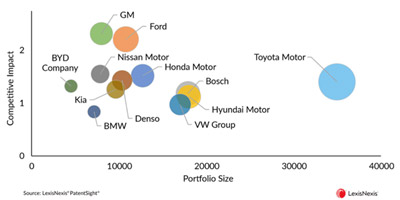
LexisNexis SDG Patent Mapping of Sustainable Innovations
By Jessica Morel, Chief Marketing Officer, Product Applications, LexisNexis Intellectual Property Solutions
Leading the charge in sustainable innovation through patent mapping.
In a world rocked by climate change, social inequality, and economic challenges, the United Nations Sustainable Development Goals (SDGs) serve as a lighthouse, guiding our progress towards achieving sustainability. These 17 goals aim to create a more equitable and sustainable world by 2030. However, achieving them requires more than just goodwill; it demands innovation and actionable insights.
The term "sustainability" is an oft-brandished buzzword. Marco Richter, Global Head of Customer Success at LexisNexis Intellectual Property Solutions, and his team are striving to give it tangible meaning. "We see the need to invest in innovation, and the part that we play as an organization in this is to bring clarity to that innovation," Richter says. Their vision is not just about the green technologies of tomorrow but about a comprehensive understanding of how each patentable invention can contribute to achieving the SDGs.
A framework that promises to redefine how we measure, understand, and strive for sustainability on a global scale.
This realization led to the development of the LexisNexis patents to SDG mapping, a project that aligns patent metadata with the SDGs. The initiative has created a framework that promises to redefine how we measure, understand, and strive for sustainability on a global scale. At the heart of the initiative is the team’s belief that patents—often seen as dry legal instruments—can be transformative tools in humanity’s quest for a more equitable and sustainable future.
Overcoming Challenges of ESG Reporting
The idea of mapping patents to SDGs emerged from LexisNexis’ exploration of how it could provide alternative data sources for the financial industry. “We saw environment, social and corporate governance (ESG) and sustainability topics as vectors to identify interesting patterns and strategies that could guide future investment potential,” Richter explains. However, the team quickly realized that existing ESG frameworks lack objectivity and consistency. Indeed, their research revealed that there are almost as many ESG standards as there are rating agencies. This prompted the team to keep searching for a more universally applicable set of rules. “We needed an authority that gave us clear, globally recognized guidelines on what is and isn’t sustainable,” says William Mansfield, Head of Customer Success for US & EMEA at LexisNexis Intellectual Property Solutions.
Mapping Patents to the SDGs

They found the solution in the SDGs. “Here, we discovered a really robust framework that is very clear and highly detailed and that has been developed through contributions from member countries worldwide,” Mansfield adds. “The SDGs that we see today are the product of some 50 years of negotiations,” he notes, emphasizing the depth and complexity of the framework they chose to align with. “There’s a lot of discussion and alignment that has gone into defining sustainability and not just from one person or one culture’s point of view, but from all countries and organizations that make us the United Nations.”
The mapping exercise was a massive undertaking involving extensive research and development.
Monitoring progress towards the sustainable development goals
By mapping the SDGs to the patent database that forms the foundation of their analytics solution, PatentSight, and by leveraging their patent quality measurement metric, Patent Asset Index, LexisNexis has provided an objective measure for sustainable innovation. The insights derived from their tool enable companies to monitor their progress toward developing sustainable technologies, showcase their efforts to investors, and identify potential partners and licensing targets.
The mapping exercise was a massive undertaking involving extensive research and development. “Developing the mapping and creating this report were huge tasks,” Mansfield notes. “The team had to sift through thousands of pages of documentation and develop search strategies to capture the patents that aligned with each SDG, while simultaneously minimizing noise in the data. This meant performing lots of reviews, testing with customers, and multiple rounds of feedback to iterate and increase the accuracy of the analyses.” Mansfield adds.
Assessing a company's level of innovation and sustainability
The mapping exercise, which began in 2020, has far-reaching implications. “It started in the financial industry, but it turns out that the opportunities are much broader than just making better investment decisions,” Richter notes. One of the most significant contributions of this mapping is its ability to cut through the marketing noise and greenwashing that often accompany corporate sustainability claims. “Patents provide an unbiased view of a company’s innovation efforts,” Mansfield emphasizes. This objectivity is crucial for investors, consumers, and other stakeholders who want to make informed decisions.
Patents provide an unbiased view of a company’s innovation efforts.
Global Sustainable Innovation Landscape Report
In July 2023, LexisNexis released their first ever global SDG report, Exploring the Global Sustainable Innovation Landscape: The Top 100 Companies and Beyond. Emphasizing the reasoning behind publishing a report on sustainable innovation, Richter elaborates, “We felt the need to give more people than just ‘our customers’ access to the valuable information delivered by the SDG to patent mapping initiative.” Considering the benefits of following such a unique approach, Mansfield adds, “We can use PatentSight charts and the mapping to see what people are doing right and then objectively compare one company with another in a fairer way than with any other means. Here we have something that is much clearer and more transparent.”
The report features new insights into regional and market dynamics shaping sustainable intellectual property strategies, industry deep dives, and in-depth analysis on specific SDGs, along with visualizations illustrating the SDG-relevant patent landscape. It also shows how corporations and governmental bodies can leverage patent analytics to accelerate sustainable innovation.
In reflecting on his team’s motivation for creating the report Richter recalls a quote from former UN Secretary General Ban Ki-moon: “we need to have various systematic and scientific checking and assessment of the situation. Information and data can play a vital role. Without knowing how much progress we’re making we will not be able to know where we’re going.”
Mapping Sustainable Innovations using Patent Analytics
The report that primarily ranked the world’s corporate innovators based on the strength of their sustainable innovation portfolio also included specific deep-dive sections that looked at individual industries witnessing disruptive trends in sustainability-related inventions. One such industry was the automotive sector, which has seen a recent wave of sustainable innovations sparked by the advent of electric cars.
Technology companies can utilize patent analysis to evaluate their innovative potential and establish themselves as market leaders…
In the automotive market, a brand’s long-term sustainability is not solely determined by market share. Technology companies can utilize patent analysis to evaluate their innovative potential and establish themselves as market leaders, effectively influencing consumer decisions and communicating with stakeholders. With patent analytics, car manufacturers can demonstrate their dedication to supporting sustainable progress through technology development.
In Figure 1, which represents the number of SDG-relevant patents in a portfolio, Portfolio Size is illustrated on the horizontal axis, and the average quality of patents in the portfolio, as measured by our proprietary average patent family quality metric, “Competitive Impact,” is on the vertical axis. Toyota Motors leads the pack in sustainable innovations in the automotive space, with the most extensive and robust portfolio as measured by the Patent Asset Index (represented by the bubble size).

portfolio size of patent owners in the Automotive industry sector
by their SDG-related patent portfolios. The bubble size of the patent
owners represents the portfolio strength (Patent Asset Index).
Are Tesla cars sustainable according to the LexisNexis SDG patent mapping?
Interestingly, Tesla, the electric vehicle pioneer, is missing from the list. This is primarily because, despite contributing to lowering carbon emissions, Tesla licenses a large share of its technology. For this reason, the Tesla portfolio does not meet the minimum requirement for SDG-related patents to be included in the report.
Like this analysis, the full report from LexisNexis includes additional analyses of global trends and a deep dive into the Chemicals and Materials industry.
Accelerating Progress on SDGs by 2030
Innovation analytics: Guiding the path to a sustainable future.
The COVID-19 pandemic has underscored the limitations of relying solely on behavioral change to achieve sustainability goals. “We need to place our biggest bets on innovation to help us achieve these goals,” Richter asserts. LexisNexis plans to update and expand its report annually, incorporating more data sources and indicators for a comprehensive analysis. “We’ve laid an excellent foundation; now, we need to enable as many companies as possible to use it right,” Mansfield says. By doing so, LexisNexis aims to accelerate the achievement of the SDGs by 2030, contributing to a more sustainable and prosperous future for all.
We need to place our biggest bets on innovation to help us achieve these goals.
Getting buy-in from Major Corporations for using PatentSight to reach SDGs
The company has ongoing conversations with major corporations like Merck and Siemens, who already include PatentSight analyses in their Annual Reports and respective corporate sustainability reports. These dialogues have already led to improvements in the mapping. For instance, a discussion with Merck led to the inclusion of a technology that would be used in smart homes, which was initially not retrieved in their search. “The mapping will be constantly updated and improved upon as we get more customers using and engaging with the insights,” Mansfield adds. “We aim to collaborate with enterprises to enhance their understanding and utilization of our analytics. This empowers auditors to conduct more effective audits and instill confidence in business leaders to make informed decisions based on our comprehensive mapping and reports.”
LexisNexis Intellectual Property Solutions has set a new standard in the realm of sustainable innovation. By mapping patents to the SDGs, they have created a robust, objective framework that benefits not just business and commerce but society at large. As companies and investors increasingly align their strategies with sustainability goals, LexisNexis’ pioneering work serves as both a tool and a testament to the transformative power of innovation.
As part of our common effort to achieve sustainable development goals by 2030, WIPO will explore on World Intellectual Property Day 2024 how IP can encourage sustainable innovations to achieve the UN’s SDGs.
The WIPO Magazine is intended to help broaden public understanding of intellectual property and of WIPO’s work, and is not an official document of WIPO. The designations employed and the presentation of material throughout this publication do not imply the expression of any opinion whatsoever on the part of WIPO concerning the legal status of any country, territory or area or of its authorities, or concerning the delimitation of its frontiers or boundaries. This publication is not intended to reflect the views of the Member States or the WIPO Secretariat. The mention of specific companies or products of manufacturers does not imply that they are endorsed or recommended by WIPO in preference to others of a similar nature that are not mentioned.